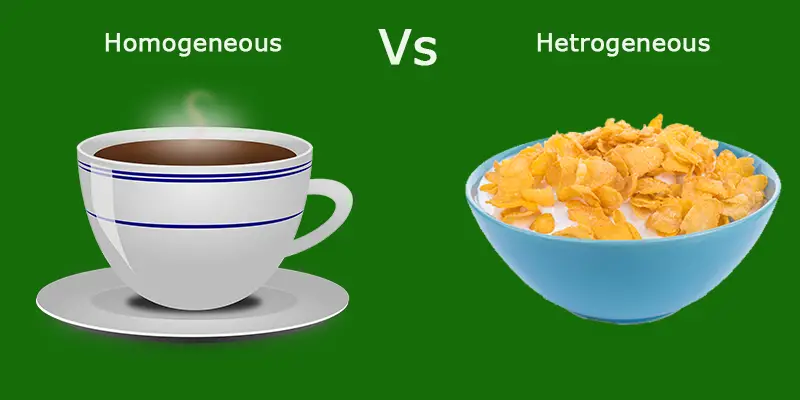Almost everything we see around us is nothing but a mixture of one or more substances whether it’s the food we eat which is a mixture of different ingredients or the air we breathe which is a combination of gases or solid metal alloy combinations that make up steel or brass. The mixtures are divided into 2 groups. What is the difference between Homogeneous and Heterogenous mixtures?
- Homogeneous mixtures are uniform in structure
Ex. salt into water, this mixture of salt dissolves into H2O & is hard to separate - Heterogeneous mixtures are non-uniform structures with at least 2 components & 2 phases that remain separate from each other easy to see & clearly identifiable
Ex.ice in soda
When you combine two or more materials, you form a mixture. In chemistry, a mixture is a combination that does not produce a chemical reaction. There are two categories of mixtures of homogeneous mixtures and heterogeneous mixtures.
Homogeneous Mixture
A Homogeneous mixture is a combination of two or more substances that are physically combined. They also can be separated and taken out by a physical method. As there are no chemical changes involved, the components’ individual properties that were mixed together remain the same.

In a mixture, each component has its own identity and is the same in mixture. During the formation of a mixture, there is no change in energy, and the Boiling point and the melting point of the mixture depending upon the characteristics of the constituents.
Impure substances are also referred to as a mixture. The components look to be one of the same. They can be liquid, gas, or solid and no matter how closely you look at them the chemical composition is the same as the mixture.
With Homogeneous mixtures, you can’t tell if it’s a mixture element or compound because the particles that make it up are evenly distributed. These Homogenous mixtures can be classified by:
- Suspension-the particles are suspended throughout the solution in bulk and can be seen easily by our naked eyes.
- Solution- solutions can be defined as a homogeneous mixture of two or more components. The size of solute particles (the substance that dissolves) in the solutions is extremely small and is always present in a lower concentration. It is normally less than 1 nm in diameter.
- Colloidal solutions or Colloids- are mixtures in which microscopically dispersed insoluble particles of one substance are suspended in another substance
Types of Homogeneous Mixtures
- Saltwater-The ocean has a specific amount of salt particles that are evenly dissolved in water called an Aqueous Solution (ag)
- Cement – a solid homogeneous mixture of calcium compounds is mixed with sand, gravel, and H2O
- Bitumen – the solid form of petroleum and source of gasoline, diesel, and other fossil fuels
- Blood plasma – the colorless fluid that holds your blood cells in suspension
- Water – is a great example of a homogeneous mixture because all but the purest water contains dissolved minerals and gases
Heterogeneous Mixture
A Heterogeneous mixture is a mixture with non-uniform or more simply different components in a composition. It’s not the same and the compositions can vary by position.  The composition varies from one region to another with at least two phases that remain separate from each other, with clearly identifiable properties.
The composition varies from one region to another with at least two phases that remain separate from each other, with clearly identifiable properties.
They are both considered pure properties and can be distinguished when you look at them. If you closely examine a sample of a heterogeneous mixture, you will see the separate components in the mixture. Whether a mixture is heterogeneous or homogeneous depends on how closely you examine it. Sand may appear Homogeneous from a distance, yet when you magnify it, it is Heterogeneous.
With Heterogeneous mixtures often appear in layers or chunks and clumps indicating there is a mixture of 2 or more unevenly distributed substances.
Some mixtures are a little tricky and harder to confirm and depend on the phase, which is any part of a sample that has a uniform composition and properties. A heterogeneous mixture consists of two or more phases.
An unopened soda in a bottle has a uniform composition and is a homogeneous mixture but once you open the soda bottle, bubbles appear in the liquid. The bubbles from carbonation are gasses, while the majority of the soda is liquid. An opened can of soda is an example of a heterogeneous mixture.
Types of Heterogeneous Mixtures
Solid and solid combinations can be easily seen or identified and separated:
- Saltwater/Sand Mixture– The same sample of ocean water contains an uneven amount of sand particles in a suspension that can be removed by filtering
- Olive Oil liquid and Water-separate into 2 layers
- A Hamburger– with different ingredients (bun, cheese, salad, ketchup & mustard) that don’t mix together a type of Heterogenous Mixture
- Mixed nuts – Mixed nuts are a type of heterogeneous mixture, which can be separated into individual parts.
- Soil – Soil is an example of a heterogeneous mixture in solid form
- Vinaigrette salad dressing – A bottle of balsamic vinaigrette salad dressing is a mixture that is heterogeneous
- Clouds – You can see clouds in the sky because it’s a heterogeneous gas mixture. Water vapor goes up into the sky and mixes with air creating visible clouds.
If the solid material or particles are lighter they will float to the top of the liquid solution and if the particles or material are heavier, then they will sink to the bottom of the solution.
Mixing together two solids, without melting them together, typically results in a heterogeneous mixture. Examples include sand & sugar, salt and gravel, a basket of produce, and a toy box filled with toys.
JimGalloway Author/Editor

References:
Vedantu-What are Homogenous Mixtures?
Libre Texts Chemistry-What is a Mixture
